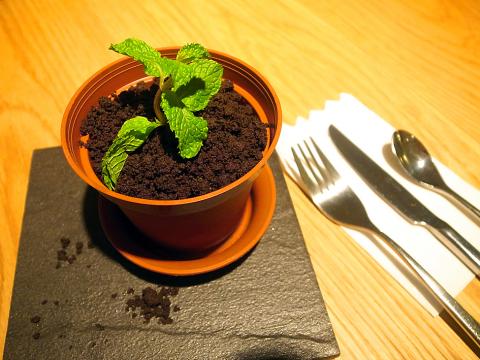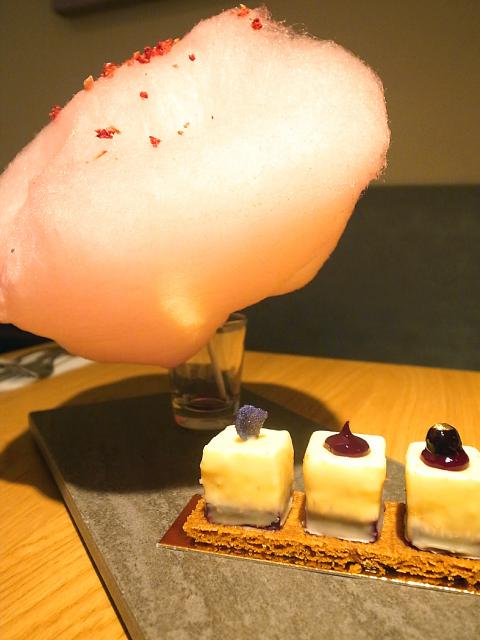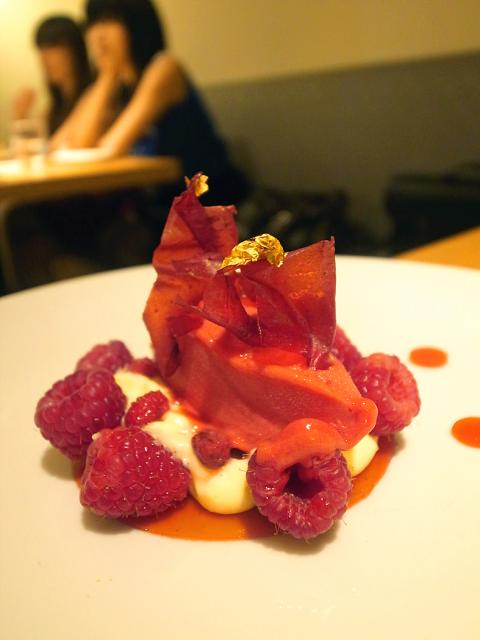Season Cuisine Ptissiartism was an instant hit when it opened last August in a pleasantly quiet residential neighborhood in the Dazhi District (大直). Dessert lovers flock to this confectionery-cum-restaurant because of one man: Season Hung (洪守成), a celebrated patissier who has earned a strong following with his innovative spirit and artistic flair for orchestrating fine desserts with striking presentation.
Under Hung, the establishment boasts an array of confections that are ingeniously prepared to photogenic perfection. Humor and playfulness sometimes play a role, too. Take, for example, the afternoon tea set (NT$520), which includes pink cotton candy sprinkled with tasty bits of dried strawberry and is as lovely as a fluffy, buttery cloud. On the side, an amuse bouch plate was composed of four bites of sweets, including hami melon sorbet, honeyed almond ball and a piece of madeleine. Though the cake didn’t evoke a Proustain moment, it did elicit a pleasant sensation in my mouth when melting in the fragrant, mellow-tasting French breakfast tea by Mariage Freres I chose to accompany my tea sea.
The simply tagged “plant” (NT$280) looks exactly like its name and offers plenty of entertainment as diners work their way down from a layer of chocolate crumble (the soil), vanilla ice cream mixed with fresh peppermint leaves to the bottom made from chocolate sponge cake.

Photo: Ho Yi, Taipei Times
Hung’s exploration of flavors is best illustrated in his creation of litchi souffle (NT$450), which is definitely one of the restaurant’s highlights. Accompanied by litchi and raspberry sorbet and a shot of litchi-flavored sparkling wine, the patissier’s rendition of souffle is remarkably light and is not cloying thanks to its summery, fruity aromas.
The chestnut crepe (NT$280) is another creative remake of a classic. The pancake, instead of lying flat on the plate, is wrapped up in rolls and adorned with vanilla bean ice cream and chocolate cornflakes.
The restaurant is also famous for its mille feuille (NT$350), chestnut pound cake (NT$600) and macaron (NT$280 for a bag of four) which was unfortunately sold out on the Sunday afternoon my sweet-tooth friends and I visited.

Photo: Ho Yi, Taipei Times
The establishment’s popularity makes advance reservations essential. We booked one month ahead, and even so, were fortunate to get a big table in the packed and comparatively small venue. The service is fast, and with the soothing colors of white and light wooden brown, the warmly lit place possesses an elegant simplicity and was free from girlish patrons snapping away amidst cries of admiration.
All in all, Season Cuisine Patissiartism earns accolades for offering sweet feasts that please both the eye and the palate, though sometimes the look surpasses the taste. Diners with a savory appetite may want to come for the restaurant’s lunch sets. The establishment also provides service for private dinners and parties as well as catering. More information can be found at www.facebook.com/SEASON.CuisinexPatissiartism.

Photo: Ho Yi, Taipei Times

In the March 9 edition of the Taipei Times a piece by Ninon Godefroy ran with the headine “The quiet, gentle rhythm of Taiwan.” It started with the line “Taiwan is a small, humble place. There is no Eiffel Tower, no pyramids — no singular attraction that draws the world’s attention.” I laughed out loud at that. This was out of no disrespect for the author or the piece, which made some interesting analogies and good points about how both Din Tai Fung’s and Taiwan Semiconductor Manufacturing Co’s (TSMC, 台積電) meticulous attention to detail and quality are not quite up to

April 21 to April 27 Hsieh Er’s (謝娥) political fortunes were rising fast after she got out of jail and joined the Chinese Nationalist Party (KMT) in December 1945. Not only did she hold key positions in various committees, she was elected the only woman on the Taipei City Council and headed to Nanjing in 1946 as the sole Taiwanese female representative to the National Constituent Assembly. With the support of first lady Soong May-ling (宋美齡), she started the Taipei Women’s Association and Taiwan Provincial Women’s Association, where she

Chinese Nationalist Party (KMT) Chairman Eric Chu (朱立倫) hatched a bold plan to charge forward and seize the initiative when he held a protest in front of the Taipei City Prosecutors’ Office. Though risky, because illegal, its success would help tackle at least six problems facing both himself and the KMT. What he did not see coming was Taipei Mayor Chiang Wan-an (將萬安) tripping him up out of the gate. In spite of Chu being the most consequential and successful KMT chairman since the early 2010s — arguably saving the party from financial ruin and restoring its electoral viability —

It is one of the more remarkable facts of Taiwan history that it was never occupied or claimed by any of the numerous kingdoms of southern China — Han or otherwise — that lay just across the water from it. None of their brilliant ministers ever discovered that Taiwan was a “core interest” of the state whose annexation was “inevitable.” As Paul Kua notes in an excellent monograph laying out how the Portuguese gave Taiwan the name “Formosa,” the first Europeans to express an interest in occupying Taiwan were the Spanish. Tonio Andrade in his seminal work, How Taiwan Became Chinese,